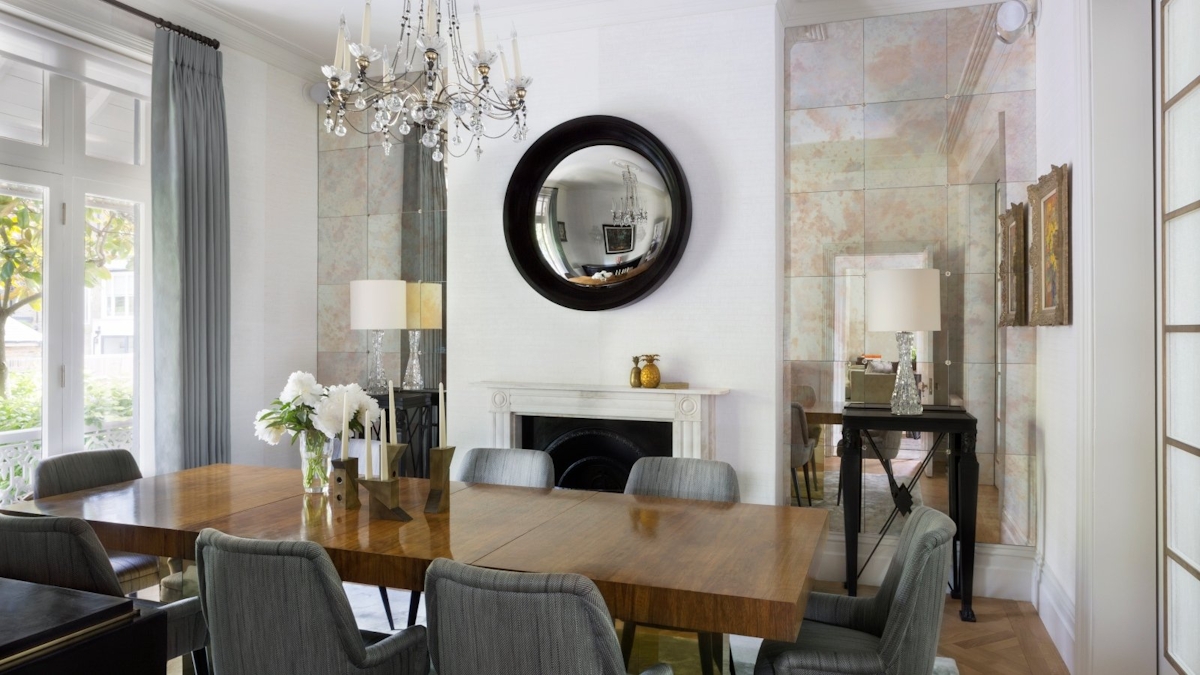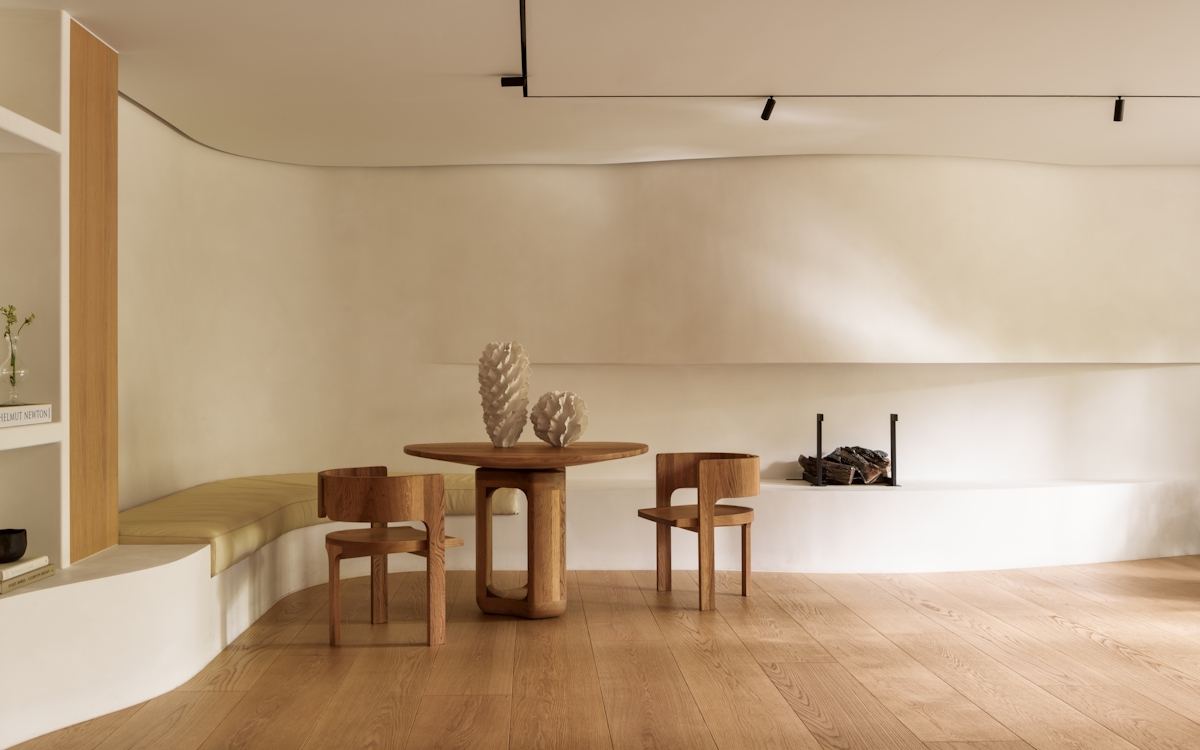From small living room layouts that you thought mightn’t be achievable to thinking up storage for small bedrooms that doesn’t take up too much floor space, there are plenty of tricks up an interior designer’s sleeve that solves the conundrum of how to make a small room look bigger. LuxDeco’s resident Interior Design Director Linda Holmes shares her go-to tips that translate across all of the possible small rooms under your roof.

How To Make A Small Room Look Bigger
From New York City micro-bathrooms to London townhouses, small rooms are a reality for many of us

Keep furniture to a minimum
Small room designs should never go overboard on furniture. Naturally the room still needs to function as a room (so don’t furnish a small living room with just a sofa, side table and nothing more), but do try to keep the number of objects in the room reduced. Instead of a large sofa, an armchair and a footstool, for example, consider a large L-shaped sofa. The fewer pieces that your eye has to read, the less cluttered the space will feel.
Similarly, in a small bedroom, even if in your heart of hearts you want a dressing table, chest of drawers and wardrobe, and you’ve found minute versions of each to make it all possible, it’s best to step back and pick just one or two pieces of furniture instead. Your room will absolutely feel more spacious for it.
Can your furniture multitask?
To help with point one, when selecting furniture for a small room, ask yourself whether any items can multitask. Back to the small living room layout, if you’d prefer a large three-seater or four-seater sofa but also want a footstool, could you choose a firm-top ottoman that can double up as a coffee table with a decorative tray on top? Two pieces of furniture achieved in one.
Or in that bijou boudoir, could you pick a low-height chest of drawers and dress it with a mirror so that it serves as bedroom storage as well as a makeshift dressing table? You’ll feel like you’ve had to make less of a compromise when you discover ways that furniture can fulfil more than one role, making your small room appear seemingly larger, more functional and enjoyable to live with.
Use colour to help walls recede and your ceiling to inch higher
As an interior designer, colour will always be one of my essential tools in playing with a room’s proportions. It’s crucial to choose a colour that you love, but to discover a selection of hues that will play to your room’s strengths or help with its weaknesses.
If you do want to use colour to help your room feel larger, first look upwards and consider how to make it loftier. Painting your ceiling the same colour as the walls means there’s no interruption in where the walls start and end. Blurring the lines doesn’t draw attention to the ceiling (which defines the room’s height), ergo making the ceiling appear higher.
Painting all the elements in your room the same colour can have a similar effect in making it appear more spacious and airy. Radiators, architraves and even furniture in some instances (think built-in wardrobes or bookcases) painted in the same colour as your walls means everything melds into one. Again, it’s about giving your eye fewer elements to read.
Place mirrors in strategic spots
Like colour, mirrors are another fabulous tool to make the most of in any room, but in a small living space, they can open it up, allow it more breathing room, and bounce more light which enhances its feeling of light and space.
In a small bathroom with no windows, consider an arched window mirror. Its curved shape will add softness to your room and give the illusion of a window at the very least. Mirroring in a small city kitchen also works wonders. An antiqued mirror backsplash, with its smoked, dappled effect, is a worthy and stylish choice. Should you have an open-plan kitchen it can reflect the view of what’s going on behind you so that your space feels larger and you’re less cut off if cooking while entertaining too.
Regardless of which small space you’re decorating, look to reflect a view that you wish to see twice. Could a mirror reflect a window to double the natural light and vistas beyond? Or is there attractive exposed stonework in the room that you could reflect so that your mirror gives the illusion of a doorway leading out to another room altogether?
And select fabric colours that melt into the walls
What is true of paint colour is also applicable to your upholstery choices. A small living room will look larger if you carefully select a fabric for your sofa which is similar in tone to that of your walls. Or, be especially savvy and pick a patterned wallpaper whose print is used on your sofa too. It’s a smart choice but also a striking one. It won’t be for everyone, but a sofa colour that matches your wallpaper’s main backdrop is another way to go. Essentially, keep in mind the notion of blurring the lines between your room’s elements. The more that one piece flows into the next, the larger your space will seem.
Go for unfussy window treatments
A beautifully dressed window—fully-lined curtains, pelmets and all—can be a room’s greatest feature, but in a small setting, it can soon become overwhelming. When it comes to volume, curtains can be pretty generous which might be a lot to put onto a small room’s shoulders; the weight can appear simply too heavy.
Keep such a display for a more spacious part of your home and instead look at options that are less bulky such as a Venetian blind or fabric roller blind in a pretty fabric. You can dress up these slimmed down window treatments with a decorative trim or valance-style drape even. Plantation shutters are another sensible option in a small room, allowing you to control how much natural light you allow in and what level of privacy you need at different times of the day. In a bedroom or dressing room, sheer drapes are another lovely option or a delicate cafe curtain for a kitchen which will conceal the bottom half of your window without obscuring the natural light.
Welcome pattern, but in the right scale
Pattern is a wonderful thing, adding tone and visual texture to a room, but it can also add heaviness and complication if it’s not chosen with careful consideration.
In a small space, there’s one school of thought which is to keep patterns simple and clean-lined. Pinstripe wallpaper, for example, that will elongate your walls and draw your eye upwards is certainly one way to make a small room feel larger. Yet other interior designers will encourage you to go maximalist and embrace the confines of a small room. A heavily decorated room is another strategy for concealing the edges of walls, and can especially help if your small room has awkward, asymmetric architecture like sloped ceilings.
If you decide to mix up patterns in your small room, just be mindful of there being sensitivity in tone from one print to the next. Pattern scales should be balanced proportionally so that you drift from pattern to pattern rather than being knee-jerked from large geometric to ditsy floral and back again.
Think about visually lightweight materials, like glass and metal
Certain pieces will appear visually lighter, which in turn are less dominating in your small room design. Picture for example a brass edged glass console table versus an ornate walnut piece—the difference is instantly noticeable. Nobody is saying that you can’t have these heavier items of furniture in your small room, but if you decide to, try to balance them out with lighter materials and finishes to avoid your room feeling cramped.
Free up floor space in any way you can
Whether it’s furniture or accessories, try to make some of your choices wall-hung to free up much-needed floor space. In a small bedroom design, could your bedside tables or even bedside shelves be wall-hung? Can mirrors be wall-mounted rather than lean-to designs? And remember the simple beauty of a wall light in place of a floor lamp or bedside lamp wherever possible.
Don’t try to make it be something that it’s not
And finally, one of the principal tenets of decorating a small room is accepting its fate as such. There are plenty of tactics that you can employ to create the illusion of more space, but a small room will, by its very nature, always be a small room. Embrace its proportions rather than trying to force it to be something it’s not and learn to love what it has to offer. Remember, so often the best things come in small packages.

